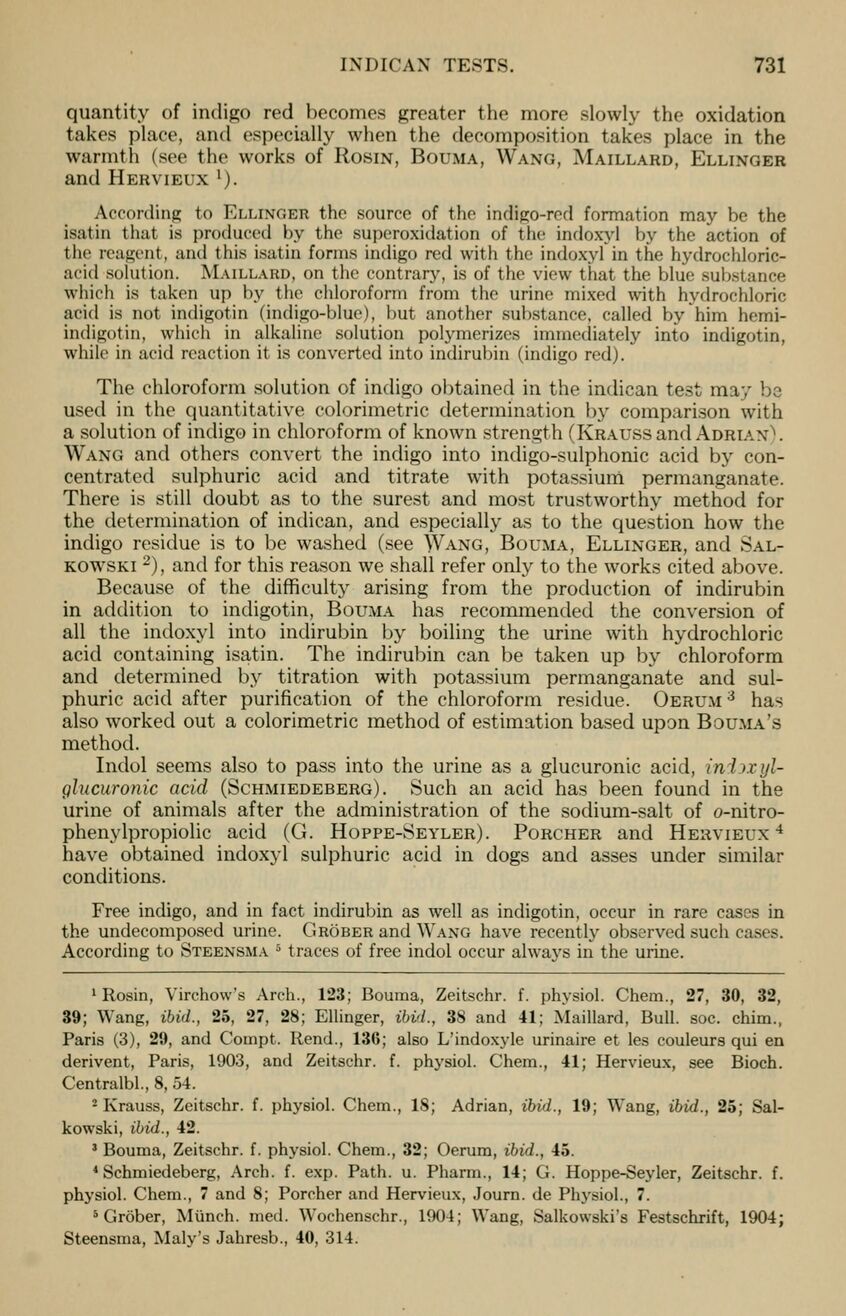
Full resolution (JPEG) - On this page / på denna sida - XIV. Urine - II. Organic Physiological Constituents of Urine

<< prev. page << föreg. sida << >> nästa sida >> next page >>
Below is the raw OCR text
from the above scanned image.
Do you see an error? Proofread the page now!
Här nedan syns maskintolkade texten från faksimilbilden ovan.
Ser du något fel? Korrekturläs sidan nu!
This page has never been proofread. / Denna sida har aldrig korrekturlästs.
IN I) [CAN TESTS. 731
quantity of indigo red becomes greater the more slowly the oxidation
takes place, and especially when the decomposition takes place in the
warmth (see the works of Rosin, Bouma, Wang, Maillard, Ellinger
and Hervieux 1
).
According to Ellingeb the source of the indigo-red formation may be the
isatin that is produced by the superoxidation of the indoxyl by the action of
the reagent, and this isatin forms indigo red with the indoxyl in the hydrochloric-
acid solution. Maillard, on the contrary, is of the view that the blue substance
which is taken up by the chloroform from the urine mixed with hydrochloric
acid is not indigotin (indigo-blue), but another substance, called by him hemi-
indigotin, which in alkaline solution polymerizes immediately into indigotin,
while in acid reaction it is converted into indirubin (indigo red).
The chloroform solution of indigo obtained in the indican test may be
used in the quantitative colorimetric determination by comparison with
a solution of indigo in chloroform of known strength (Krauss and Adrian).
Wang and others convert the indigo into indigo-sulphonic acid by con-
centrated sulphuric acid and titrate with potassium permanganate.
There is still doubt as to the surest and most trustworthy method for
the determination of indican, and especially as to the question how the
indigo residue is to be washed (see Wang, Bouma, Ellinger, and Sal-
kowski 2
) , and for this reason we shall refer only to the works cited above.
Because of the difficulty arising from the production of indirubin
in addition to indigotin, Bouma has recommended the conversion of
all the indoxyl into indirubin by boiling the urine with hydrochloric
acid containing isatin. The indirubin can be taken up by chloroform
and determined by titration with potassium permanganate and sul-
phuric acid after purification of the chloroform residue. Oerum 3
has
also worked out a colorimetric method of estimation based upon Bouma ’s
method.
Indol seems also to pass into the urine as a glucuronic acid, inlnyl-
glucuronic acid (Schmiedeberg). Such an acid has been found in the
urine of animals after the administration of the sodium-salt of o-nitro-
phenylpropiolic acid (G. Hoppe-Seyler). Porcher and Hervieux 4
have obtained indoxyl sulphuric acid in dogs and asses under similar
conditions.
Free indigo, and in fact indirubin as well as indigotin, occur in rare cases in
the undecomposed urine. Grober and Wang have recently observed such
According to Steensma 5
traces of free indol occur always in the urine.
1
Rosin, Yirchow’s Arch., 123; Bouma, Zeitschr. f. physiol. Chem., 27, 30, 32,
39; Wang, ibid., 25, 27, 28; Ellinger, ibid., 38 and 41; -Maillard, Bull. soc. chim.,
Paris (3), 29, and Compt. Rend., 136; also L’indoxyle urinaire et les couleurs qui en
derivent, Paris, 1903, and Zeitschr. f. physiol. Chem., 41; Hervieux, see Bioch.
Centralbl., 8, 54.
2
Krauss, Zeitschr. f. physiol. Chem., 18; Adrian, ibid., 19; Wang, ibid., 25; Sal-
kowski, (bid., 42.
5
Bouma, Zeitschr. f. physiol. Chem., 32; Oerum, ibid., 45.
* Schmiedeberg, Arch. f. exp. Path. u. Pharm., 14; G. Hoppe-Seyler, Zeitschr. f.
physiol. Chem., 7 and 8; Porcher and Hervieux, Journ. de Physiol., 7.
5
Grober, Munch, med. Wochenschr., 1904; Wang, Salkowski’s Festschrift, 1904;
Steensma, Mary’s Jahresb., 40, 314.
<< prev. page << föreg. sida << >> nästa sida >> next page >>